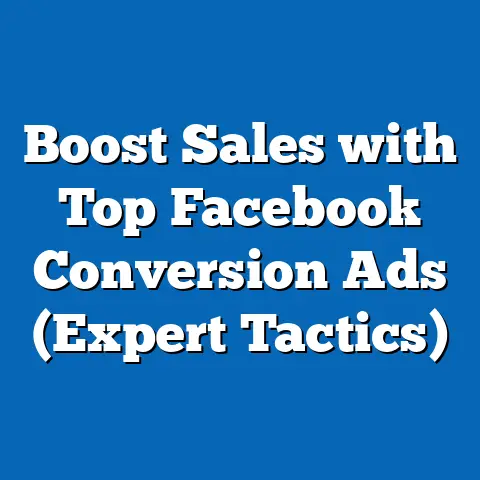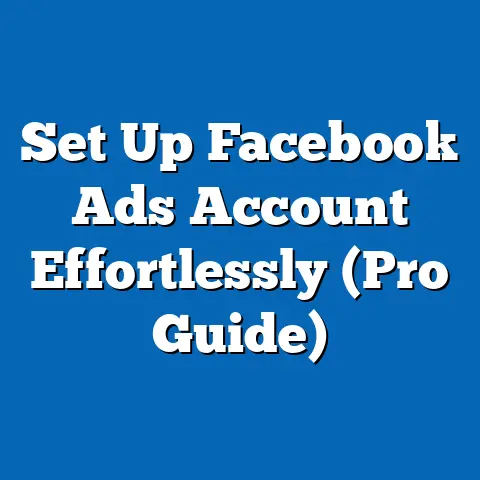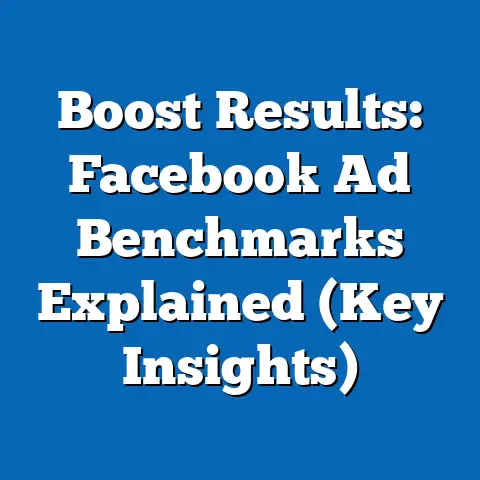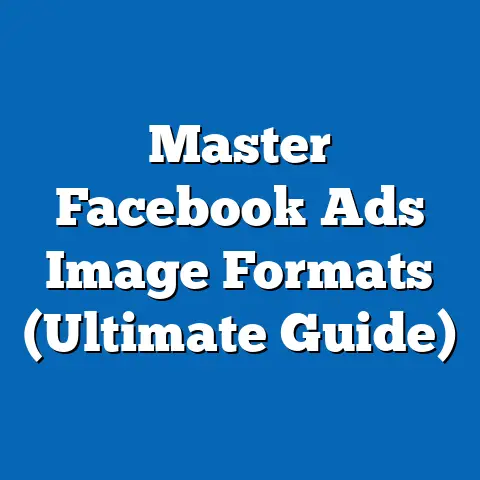Maximize Engagement with Facebook Ads Autoplay (Pro Tips)
Craftsmanship, in the digital marketing world, is more than just creating an ad; it’s an art. It’s the meticulous attention to detail, the creative spark, and the strategic thinking that transforms a simple advertisement into a compelling story that resonates with audiences. I’ve seen firsthand how a well-crafted Facebook ad, one that truly embodies craftsmanship, can skyrocket engagement, build brand loyalty, and ultimately drive conversions.
Think of it this way: would you rather watch a blurry, hastily-made video, or a beautifully shot, emotionally resonant clip that grabs your attention from the first second? The answer is obvious. And that’s where the power of Facebook Ads Autoplay comes into play. It’s not just about having a video that starts automatically; it’s about crafting an experience that captivates, informs, and inspires action.
In this guide, I’ll dive deep into the world of Facebook Ads Autoplay, offering you pro tips, actionable strategies, and a dose of my own experiences to help you master the art of creating engaging autoplay ads. We’ll explore everything from the fundamentals of autoplay to advanced optimization techniques, all with the goal of helping you craft ads that not only capture attention but also deliver real results. Get ready to level up your Facebook advertising game!
Understanding Facebook Ads Autoplay
Let’s start with the basics. Facebook Ads Autoplay is exactly what it sounds like: video ads that begin playing automatically as users scroll through their newsfeeds. It’s a powerful feature that allows your message to be seen (and hopefully heard) without the user having to take any initial action.
The mechanics are simple yet effective. As a user scrolls, the Facebook algorithm detects when your video ad is within the visible area of their screen. Once it is, the video begins playing automatically, often silently unless the user has their sound turned on. This immediate engagement is key to capturing attention in a fast-paced, content-saturated environment.
Why is Autoplay Important?
I’ve found that the biggest advantage of autoplay is its ability to immediately grab a user’s attention. In a world where people are bombarded with content, you have only a few seconds to make an impression. Autoplay eliminates the barrier of requiring a click to play, ensuring that your message is seen by a wider audience.
Consider these benefits:
- Increased Visibility: Autoplay ensures your ad is seen, even if the user doesn’t initially intend to watch it.
- Higher Engagement: By automatically starting the video, you increase the likelihood of users watching for at least a few seconds, which can significantly improve engagement metrics.
- Brand Awareness: Even a brief exposure to your brand can leave a lasting impression, boosting brand recognition over time.
Statistics Speak Volumes
While specific numbers fluctuate, studies consistently show the positive impact of autoplay on video ad performance. For example, a study by Facebook itself found that autoplay videos resulted in a significant increase in view time compared to non-autoplay videos. Other reports indicate that autoplay can boost video completion rates and lead to higher click-through rates.
I’ve seen this firsthand. In one campaign I managed for a local restaurant, switching from static image ads to autoplay video ads showcasing their mouthwatering dishes resulted in a 40% increase in website traffic and a noticeable uptick in reservations.
Takeaway: Autoplay is a powerful tool for capturing attention and increasing engagement on Facebook. Understanding how it works and leveraging its benefits is the first step to crafting successful video ads.
Crafting Compelling Autoplay Ads
Now that we understand the power of autoplay, let’s delve into the art of crafting compelling ads that truly resonate with your audience. It’s not enough to simply have a video that starts automatically; you need to create an experience that captivates, informs, and inspires action.
Visual Elements: The First Impression
Your visual elements are your first line of defense in capturing attention. With autoplay, you have mere seconds to make an impression, so your visuals need to be eye-catching, engaging, and relevant.
Tips for Choosing Visuals:
- High-Quality Imagery: This seems obvious, but it’s worth repeating. Use high-resolution images and videos that are clear, crisp, and visually appealing.
- Focus on the First Few Seconds: The first few seconds are crucial. Start with your most compelling visuals to immediately grab attention. Consider using a dynamic opening scene, a striking image, or a question that piques curiosity.
- Brand Consistency: Ensure your visuals align with your brand’s aesthetic. Use consistent colors, fonts, and imagery to reinforce brand recognition.
- Show, Don’t Tell: Instead of simply talking about your product or service, show it in action. Demonstrate its benefits and how it solves a problem.
My Experience:
I once worked with a travel agency that was struggling to gain traction with their Facebook ads. Their initial ads featured static images of destinations, which were visually appealing but didn’t capture the essence of the travel experience. We decided to create an autoplay video ad showcasing short clips of travelers enjoying various activities: hiking through lush forests, relaxing on pristine beaches, and exploring vibrant cities. The result was a dramatic increase in engagement and a surge in bookings.
Sound Design: The Emotional Connection
While many users watch autoplay videos with the sound off, don’t underestimate the power of sound design. When users do have their sound on, sound can significantly enhance the emotional impact of your ad and create a more immersive experience.
Sound Considerations:
- Voiceovers: A well-crafted voiceover can add credibility and clarity to your message. Use a professional voice actor who can convey the right tone and emotion.
- Sound Effects: Sound effects can add dynamism and excitement to your video. Use them sparingly to emphasize key moments and create a more engaging experience.
- Music: Music can set the mood and create an emotional connection with your audience. Choose music that aligns with your brand and the message you’re trying to convey.
- Consider Sound-Off Viewing: Even if you’re using sound, make sure your video is still engaging and informative when viewed without sound. Use captions and visual cues to convey your message.
Storytelling Techniques: Engage and Captivate
Storytelling is the heart of any compelling ad. Even in a short autoplay video, you can create a narrative arc that engages your audience and leaves a lasting impression.
Storytelling Tips:
- Start with a Hook: Grab attention immediately with a compelling opening scene, a thought-provoking question, or a surprising statement.
- Identify a Problem: Clearly define the problem that your product or service solves. This creates a sense of relatability and urgency.
- Offer a Solution: Present your product or service as the solution to the identified problem. Highlight its benefits and how it makes life easier or better.
- Create an Emotional Connection: Tap into your audience’s emotions by telling a story that resonates with their values, aspirations, or pain points.
- Keep it Concise: Autoplay videos are typically short, so keep your story concise and to the point. Focus on the most important elements and avoid unnecessary details.
Call-to-Action (CTA): Encourage Action
Your call-to-action (CTA) is the final piece of the puzzle. It’s the instruction that tells your audience what you want them to do next. Make sure your CTA is clear, compelling, and easy to understand.
CTA Best Practices:
- Be Specific: Tell your audience exactly what you want them to do. Use clear and concise language like “Shop Now,” “Learn More,” or “Sign Up Today.”
- Create Urgency: Use language that creates a sense of urgency, such as “Limited Time Offer” or “Don’t Miss Out.”
- Make it Prominent: Ensure your CTA is visually prominent and easy to find. Use a contrasting color or a clear button to make it stand out.
- Test Different CTAs: Experiment with different CTAs to see which ones perform best. Try different wording, colors, and placements to optimize your results.
Takeaway: Crafting compelling autoplay ads requires a combination of eye-catching visuals, thoughtful sound design, engaging storytelling, and a clear call-to-action. By mastering these elements, you can create ads that capture attention, resonate with your audience, and drive real results.
Optimizing Autoplay for Different Audiences
One of the most powerful features of Facebook advertising is its ability to target specific audiences based on demographics, interests, behaviors, and more. When it comes to autoplay ads, this targeting capability is even more crucial. What resonates with one audience may fall flat with another, so it’s essential to tailor your autoplay content to the specific demographics you’re trying to reach.
Audience Targeting and Segmentation
Before you even begin creating your autoplay ad, take the time to thoroughly research and understand your target audience. Consider these factors:
- Demographics: Age, gender, location, education level, income, etc.
- Interests: Hobbies, passions, favorite brands, etc.
- Behaviors: Online activity, purchase history, engagement with specific content, etc.
Once you have a clear understanding of your audience, you can segment them into smaller groups based on shared characteristics. This allows you to create more targeted autoplay ads that speak directly to their needs and interests.
Analyzing Audience Behavior and Preferences
Facebook provides a wealth of data and analytics that can help you understand how your audience is responding to your ads. Pay close attention to these metrics:
- View Time: How long are people watching your autoplay video?
- Completion Rate: What percentage of viewers are watching your video to the end?
- Engagement Rate: How many people are liking, commenting, and sharing your video?
- Click-Through Rate: How many people are clicking on your CTA?
By analyzing these metrics, you can identify which autoplay ads are resonating with specific audiences and which ones need improvement.
A/B Testing for Optimal Results
A/B testing is a powerful technique for determining which autoplay ads perform best with specific demographics. Create two or more versions of your ad, each with a slight variation (e.g., different visuals, different headlines, different CTAs), and then run them simultaneously to see which one generates the best results.
My A/B Testing Story:
I once managed a campaign for an online clothing retailer that was targeting two distinct audiences: young adults interested in fast fashion and older adults interested in classic styles. We created two different autoplay ads, one featuring trendy, edgy clothing and the other featuring timeless, sophisticated pieces. By A/B testing these ads, we discovered that the fast-fashion ad performed significantly better with the younger audience, while the classic-style ad resonated more strongly with the older audience. This allowed us to optimize our ad spend and generate higher returns.
Continuous Monitoring and Adjustment
The key to successful autoplay advertising is continuous monitoring and adjustment. Don’t simply create an ad and forget about it. Regularly track your metrics, analyze your results, and make adjustments as needed.
Takeaway: Optimizing autoplay ads for different audiences requires a deep understanding of your target demographics, a commitment to analyzing data, and a willingness to experiment with different approaches. By tailoring your content to the specific needs and interests of your audience, you can significantly improve your engagement rates and drive better results.
Advanced Techniques for Maximizing Engagement
Once you’ve mastered the fundamentals of autoplay advertising, you can start exploring some advanced techniques to further maximize engagement. These strategies can help you reach a wider audience, create a more personalized experience, and drive even better results.
Retargeting: Re-Engage Your Audience
Retargeting is the practice of showing ads to people who have previously interacted with your brand. This can be a highly effective way to re-engage your audience and drive conversions.
How to Use Retargeting with Autoplay:
- Target Website Visitors: Show autoplay ads to people who have visited your website but haven’t made a purchase. Remind them of the products or services they were interested in and offer a special discount or promotion.
- Target Engaged Users: Show autoplay ads to people who have liked your Facebook page, watched your videos, or interacted with your previous ads. This is a warm audience that is already familiar with your brand.
- Create Lookalike Audiences: Use Facebook’s lookalike audience feature to find new users who share similar characteristics with your existing customers. This can help you expand your reach and find new prospects.
Leveraging User-Generated Content (UGC)
User-generated content (UGC) is any content created by your customers, such as reviews, testimonials, photos, or videos. UGC can be a powerful tool for building trust and credibility.
How to Use UGC in Autoplay Ads:
- Showcase Customer Testimonials: Feature short video clips of satisfied customers sharing their positive experiences with your product or service.
- Highlight Customer Photos: Use photos submitted by your customers showcasing your product in action.
- Run a UGC Contest: Encourage your customers to create and submit their own videos or photos using your product. Feature the best submissions in your autoplay ads.
Interactive Elements: Polls and Quizzes
Adding interactive elements to your autoplay ads can significantly increase user engagement. Polls and quizzes are a great way to get your audience involved and encourage them to interact with your ad.
How to Use Polls and Quizzes:
- Ask Engaging Questions: Create polls or quizzes that are relevant to your audience’s interests and that encourage them to share their opinions.
- Offer Incentives: Provide a small reward for completing the poll or quiz, such as a discount code or a free download.
- Share the Results: Share the results of the poll or quiz with your audience. This can create a sense of community and encourage further engagement.
Combining Autoplay with Facebook’s Algorithm Insights
Facebook’s algorithm is constantly learning and adapting to user behavior. By understanding how the algorithm works, you can optimize your autoplay ads for maximum reach and engagement.
Tips for Leveraging the Algorithm:
- Use High-Quality Content: The algorithm favors content that is engaging, informative, and relevant to the user.
- Encourage Interaction: The algorithm rewards ads that generate likes, comments, shares, and clicks.
- Target the Right Audience: The algorithm is more likely to show your ad to users who are likely to be interested in it.
- Monitor Your Metrics: Pay close attention to your ad performance metrics and make adjustments as needed.
Takeaway: Advanced techniques like retargeting, UGC, interactive elements, and leveraging Facebook’s algorithm can help you take your autoplay ads to the next level. By incorporating these strategies into your advertising campaigns, you can significantly increase engagement and drive better results.
Conclusion
Mastering the craftsmanship of Facebook ads, particularly in utilizing autoplay features, is essential for marketers looking to capture attention and drive conversions in today’s fast-paced digital landscape. As I’ve shared, it’s not enough to simply have a video that starts automatically; it’s about creating an experience that captivates, informs, and inspires action.
I’ve seen countless examples of how focusing on visual storytelling, audience understanding, and continuous optimization can transform a lackluster ad into a highly engaging and effective marketing tool. Remember the travel agency I mentioned earlier? Their transformation from static images to dynamic autoplay videos resulted in a surge of bookings and a renewed sense of excitement around their brand.
I encourage you to experiment with the pro tips and strategies shared in this guide. Try different visuals, sound designs, storytelling techniques, and CTAs. Analyze your results, refine your approach, and never stop learning.
The world of Facebook advertising is constantly evolving, so it’s crucial to stay up-to-date with the latest trends and best practices. By embracing the art of craftsmanship and continuously honing your skills, you can create compelling autoplay ads that captivate your audience, build brand loyalty, and drive real results.
Now, go out there and craft some amazing autoplay ads! I’m excited to see what you create. Don’t be afraid to push the boundaries, experiment with new ideas, and, most importantly, have fun. The world of Facebook advertising is full of possibilities, and with a little bit of craftsmanship, you can unlock its full potential.






